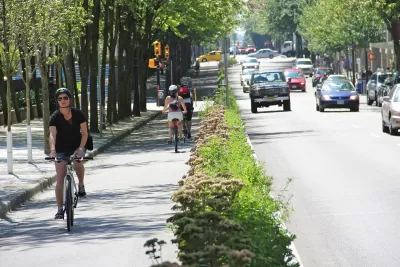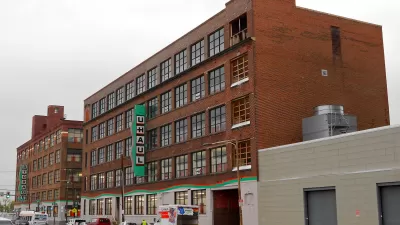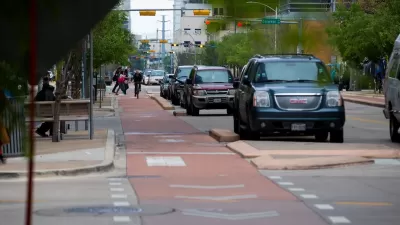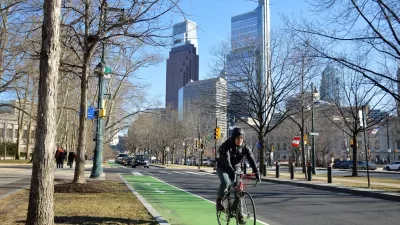Advocates in Philadelphia are pushing state lawmakers to finally pass a law to make it easier to install protected bike lanes on state routes.

Sophia Schmidt reports from Philadelphia, where a recent study into the benefits of protected bike lanes are giving local planners ammunition in their support for a proposed state law that would make it easier to build robust bike infrastructure on state routes.
“There are currently around 20 miles of protected bike lanes in the city, including parking-separated bike lanes,” according to an expert cited in the article. “But state law makes it difficult for the city to install these bike lanes on state routes that are maintained by PennDOT — which are often where they’re needed most.”
H.B. 140 would make it easier for the city to install protected bike lanes on state routes, but the bill is currently stalled in the state senate after passing the Pennsylvania House unanimously last year. The bill is also only the latest attempt, after a string of failures, to pass similar laws.
This time around, however, advocates can call on the evidence supplied by a recent report on the outcomes of a city pilot project.
In a pilot project launched in 2018, city and PennDOT officials installed parking-separated bike lanes on 10 state routes in the city, including Market Street, JFK Boulevard, Race Street in Center City, and the Chestnut Street Bridge. They’ve also evaluated case studies in peer cities, which showed parking-separated bike lanes increase perceived safety and comfort for cyclists, according to a report written by transportation consultant Kittelson & Associates, Inc.
Findings of the report include a 20 percent reduction in crashes, a 6 percent reduction of vehicle speeds, no increase in congestion, and, perhaps most strikingly, a 96 percent increase in bike trips.
FULL STORY: Philly pushes Harrisburg to pass law allowing safer bike lanes on state roads

Maui's Vacation Rental Debate Turns Ugly
Verbal attacks, misinformation campaigns and fistfights plague a high-stakes debate to convert thousands of vacation rentals into long-term housing.

Planetizen Federal Action Tracker
A weekly monitor of how Trump’s orders and actions are impacting planners and planning in America.

Chicago’s Ghost Rails
Just beneath the surface of the modern city lie the remnants of its expansive early 20th-century streetcar system.

MTA Poised to Break Ridership, On-Time Service Records
New York City’s transit system saw strong increases in ridership and improvements in service quality in the first half of 2025.

Bend, Oregon Zoning Reforms Prioritize Small-Scale Housing
The city altered its zoning code to allow multi-family housing and eliminated parking mandates citywide.

Amtrak Cutting Jobs, Funding to High-Speed Rail
The agency plans to cut 10 percent of its workforce and has confirmed it will not fund new high-speed rail projects.
Urban Design for Planners 1: Software Tools
This six-course series explores essential urban design concepts using open source software and equips planners with the tools they need to participate fully in the urban design process.
Planning for Universal Design
Learn the tools for implementing Universal Design in planning regulations.
planning NEXT
Appalachian Highlands Housing Partners
Mpact (founded as Rail~Volution)
City of Camden Redevelopment Agency
City of Astoria
City of Portland
City of Laramie





























